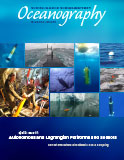Article Abstract
Future ocean observing systems will rely heavily on autonomous vehicles to achieve the persistent and heterogeneous measurements needed to understand the ocean’s impact on the climate system. The day-to-day maintenance of these arrays will become increasingly challenging if significant human resources, such as manual piloting, are required. For this reason, techniques need to be developed that permit autonomous determination of sampling directives based on science goals and responses to in situ, remote-sensing, and model-derived information. Techniques that can accommodate large arrays of assets and permit sustained observations of rapidly evolving ocean properties are especially needed for capturing interactions between physical circulation and biogeochemical cycling. Here we document the first field program of the Satellites to Seafloor project, designed to enable a closed loop of numerical model prediction, vehicle path-planning, in situ path implementation, data collection, and data assimilation for future model predictions. We present results from the first of two field programs carried out in Monterey Bay, California, over a period of three months in 2016. While relatively modest in scope, this approach provides a step toward an observing array that makes use of multiple information streams to update and improve sampling strategies without human intervention.

